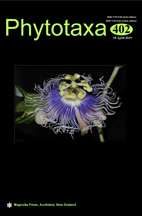Issue:
Vol. 402 No. 5: 6 May 2019
Type: Article
Published: 2019-05-06
Page range: 232–240
Abstract views: 21
PDF downloaded: 1
A new natural hybrid in the genus Laelia (Orchidaceae) from Oaxaca, Mexico
Instituto Politécnico Nacional, Centro Interdisciplinario de Investigación para el Desarrollo Integral Regional Unidad Oaxaca, Hornos 1003, Santa Cruz Xoxocotlán, 71230, Oaxaca, Mexico
Universidad Nacional Autónoma de México. Instituto de Biología. Departamento de Botánica, Ciudad Universitaria, Apdo. postal 70-367, 04510, Cuidad de México, México
Instituto Politécnico Nacional, Centro Interdisciplinario de Investigación para el Desarrollo Integral Regional Unidad Oaxaca, Hornos 1003, Santa Cruz Xoxocotlán, 71230, Oaxaca, Mexico
Universidad La Salle, Camino a San Agustín 407, Santa Crux Xoxoccotlán, 71230, Oaxaca, Mexico
Prolongación Plaza de la Merced 8, Heroica Ciudad de Tlaxiaco, 69800, Oaxaca, México
Monocots
Laelia albida
Laelia furfuracea
Laelia × tlaxiacoensis
Mixtec
new nothospecies

